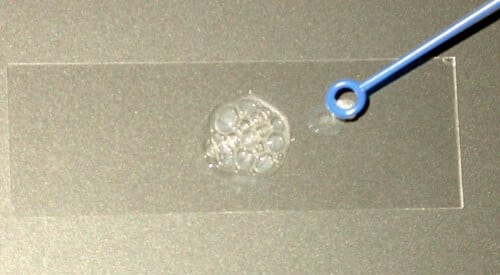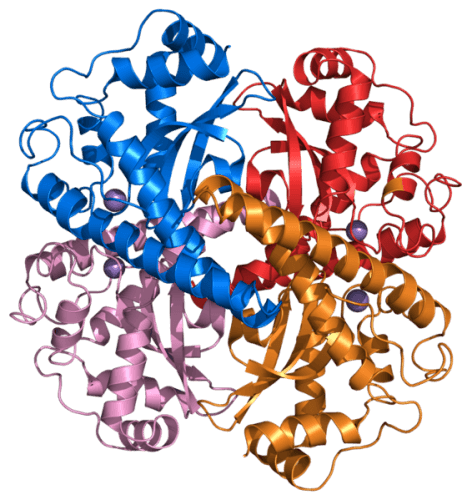In the last post we reviewed the shortening of the telomeres as one of the possible factors that lead to the aging of the body. However, the review would not be complete if we did not also examine another interesting theory regarding the origin of aging. This is the free radical theory.

In the last post we reviewed the shortening of the telomeres as one of the possible factors that lead to the aging of the body. However, the review would not be complete if we did not also examine another interesting theory regarding the origin of aging. This is the free radical theory.
According to this theory, we age as a result of ceaselessly performing the most basic action: breathing. As part of the breathing process, we consume oxygen. We need it to live, but the sad fact is that oxygen is one of the cruelest molecules we know. It likes to steal electrons from other molecules and destroy them. He does this so well that in chemistry the name 'oxidation' is given to describe the process of stealing electrons from one molecule to another. The oxygen is responsible for book pages disintegrating after many years of exposure to air, and it is capable of turning a solid block of iron into rust dust. A victim breathing pure oxygen for many hours would develop breathing difficulties, and when premature infants in incubators were exposed to high concentrations of pure oxygen, they went blind because the gas burned the retina in the eye. The explanation for all these phenomena is that oxygen creates free radicals as an inevitable part of the breathing process, and these damage the cells.

According to the free radical theory, aging is caused by the cumulative damage these molecules cause to cells over the years. We know for sure that free radicals are harmful to cells, and that the damage they cause is more common in old age. Moreover, the free radicals cause mutations - the DNA of each human cell absorbs about ten thousand oxidative damages every day, most of which are repaired, but some remain as they are. Old mice have about 2 million mutations in each cell. Young mice have only half that. The mutations can kill the cell, turn it cancerous or even damage the sperm and eggs and pass the mutations on to the next generation.
In short, there is no doubt that free radicals are not substances we want to come across in a dark alley. But are they the main cause of aging? There is still no consensus on this. There are interesting experiments such as those in which mice were injected with catalase - a human gene that breaks down free radicals inside the cells. The mice gained about 15% more longevity, mostly because heart disease and cataracts struck them later in life. The catalase protected the muscles and blood vessels against the free radicals. And that's nice, but you have to always and all the time remember that this is not 15% of the human lifespan - that is, more than ten years - but 15% of the mouse lifespan. I mean, several months. Suddenly that sounds a lot less impressive, doesn't it? And besides, what did they do anyway? Put human catalase into mice!
We can see that even in nature, long-lived plants are particularly resistant to free radicals, probably through genes called superoxide dismutases. Remember the flies that were blessed for long life? It turns out that they had a particularly strong version of superoxide dismutase. This experiment was repeated five times, and each time they found that this group of enzymes was increased in the long-lived flies. In another experiment, flies were genetically engineered to express human superoxide dismutase in their neurons - which is apparently more effective than the flies'. The lifespan of these flies increased by 40%. Similar results were also obtained in worms.
The gauntlet is thrown

And here is a question for you. Assuming that the genetic engineering treatment itself is completely safe: are you ready to have an extra copy or two of superoxide dismutase inserted into your cells?
I wouldn't be surprised if some readers nod their heads in agreement as an answer to the question. We all want to gain eternal life. But in this case, at least, you would be making a big mistake. Mutations in the superoxide dismutase 1 gene have been known in humans for years, which cause the enzyme to become hyperactive and work more than usual. We would expect such mutant humans to live to be 120 or older, but they die around age fifty from a brutal neurodegenerative disease that leads to general paralysis and death. In America, the syndrome is called Lou Gehrig's disease, after the famous baseball player who died of it.
Why does an enzyme that is usually so beneficial cause such severe disease when overexpressed? The simple answer is that no one knows. There are many guesses, and one of the best is that superoxide dismutase has an additional role in maintaining the structures of nerve cells. It is possible that SOD1 also plays a role in Down syndrome, where the child has three copies of the gene that codes for this enzyme, and the result, among other things, is mental retardation.
I hope you now understand better why we need to be so careful before we offer new treatments that have never been tested. The body is a complex and complicated system, and a change of one single gene can lead to devastating results.
And what about the most used medicine against free radicals: antioxidants? Many believe that taking antioxidants can help in the treatment of free radicals, but currently it is difficult to find good proof that this treatment results in a significant extension of life. If anything, the situation is the opposite: excessive intake of antioxidants can actually harm health.
There is still a long way to go
I don't like to be the prophet of the wrath of the bad news, but the bitter truth is that there have not yet been proven treatments in humans to prolong life. Beyond that, we are not even sure what the real reasons behind the aging phenomenon are, let alone how to prevent them.
Once we know what the real cause of aging is - free radicals, telomere shortening, or any other reason - we can treat it in a targeted manner. The shortening of the telomeres can be prevented through controlled and careful genetic engineering treatments that will result in the activation of telomerase in the body, but only temporarily so as not to disrupt the cell mechanisms. It is possible to fight free radicals in a similar way, by increasing the production of enzymes that break them down.
I don't want to sound too optimistic. Even if we uncover and decipher all the causes of aging, many more decades will pass before we can deal with them effectively. We have seen how complex the body's operating system is, and how careful we must be to play with it with our eyes closed. But these concerns should not cloud the final point: aging is a molecular process that occurs in the body, and there is no reason why we cannot prevent it in the future. For this, we will have to 'just' stand up against hundreds of millions of years of evolution, which shaped our bodies to be temporary. In doing so, we will continue the process of rebellion in nature that began when we used sharp stones instead of claws, and we used the power of fire to soften meat, as a replacement for the sharp teeth we possessed other predators.
Will the day come when we will be able to delay and even stop the aging process?
This question is unnecessary for me. This day will indeed come, of that I have no doubt.
The more important question, for me and for all of us, is when.
More of the topic in Hayadan:
"Longevity" series by Dr.Roey Tsezana
Longevity - Part One: The Road to Eternal LifePart two - the evolution that killed me
To stop death - third part in the series, "longevity of life": the hunger for life
Longevity, Part 4 When Breathing Kills: Free Radicals and Aging
Keeping death at bay: the telomere theory. Fifth article in the longevity series

12 תגובות
By the way, why worms?
An extremely short lifespan allows checking changes in lifespan in a reasonable amount of time.
Similar experiments in more developed animals may provide results for our great-grandchildren P:
"Maybe…",
not so complicated.
Worms were engineered for them without the ability to produce enzymes with antioxidant properties. According to the theory that aging is a result of oxidation, less antioxidants = more oxidative damage = faster aging = shorter life.
Miraculously, the life span of the worms did not change and in certain situations was extended by 30% (when only one SOD gene is turned off).
Because the theory of "aging is caused by oxidation" is at odds with the results. It is either incomplete or wrong. Of course there is no proof here for anything in particular that we are not worms. But science does not exist on proofs but on the inability to disprove a theory. And the results of this experiment definitely put a stick in the wheels of the theory in question. All this happened according to my best memory in 2006, I can't really find any continuity to this line of research.
By the way, who taught you and translated you into a different language? I did not understand
Actually leave it is not interesting either
very spicy
Maybe you'll also learn to shut up a little?
Moshe, sorry for the harsh reaction, mainly and especially the last sentence, I would simply rather you wait and reason with me than translate me.
I have been educated by all my teachers, even if they only translate me into a different language.
Moshe Moshe Moshe, God willing they will remove you from the site, I read the entire article in harsh language and breaking my teeth and what I found is that someone says that: "There is a situation that maybe we don't know everything"...
We knew this even before this, if you give an article in English, at least make sure that there is not the same article in Hebrew, or the same answers you claim to bring, a small number of responses before that..
I brought a link that covers everything you said and even more, why? Why?? Why?????? Why did you waste my life???
You wasted five minutes of my life, I really hope that these are not important minutes, and if they are, God will forgive you, because I am not.
I'm not a genius, I'm not smart, I'm a stupid fool who knows how to read, and if I see any link - I go in to check what it's about.
In our case, the link was 2 or 3 comments above you, aye aye aye God take me or you, just don't leave us together.
To the best of my knowledge, there are currently also studies that cast reasonable doubt that free radicals are the cause and not a correlation with a common factor for aging.
http://www.scientificamerican.com/article.cfm?id=free-radical-shift
I assume Kurzweil claims that given a sufficiently powerful computer, which can also write its own software, there is no problem at all in creating a complete simulation of the human organism, of the dozens of cell types that make it up, the hundreds of organs and tissue types, the tens of thousands of proteins, genes and RNA segments, the hundreds of thousands of types of bacteria that normally inhabit the human body, the billions of DNA nucleotides and the trillions of connections between brain cells. This way it will be possible to know exactly how to adjust the body, which genes should be changed and how to optimize certain proteins and create a superman.
Until then, we will remain with the unique experience of writing messages in "Hidan" in a panel that contains only two lines.
I pondered, if the assumption is that physical fitness prolongs life (or preserves its quality), and aging shortens life (or damages its quality), there is a strong contradiction here...
During physical training you breathe more, which means you consume more oxygen.
At that moment I turned to Dr. Google and he referred me to another doctor:
http://www.wingate.org.il/Index.asp?ArticleID=3667&CategoryID=635
It turns out that you need a certain balance in physical activity and matching it with proper nutrition.
What is better? Long life with a strict diet and fitness regime or eat and drink because tomorrow we die?
Well come on, I decided to run to the nearest pub.
Sorry, but where is episode 3 about the Tolmers??
Roy! What about Kurzweil and his claim that nanotechnology will do the job already in the next twenty years? The man clearly predicted processes many years before projects like the Blue Brain arose. I know you are familiar with the singularity vision.